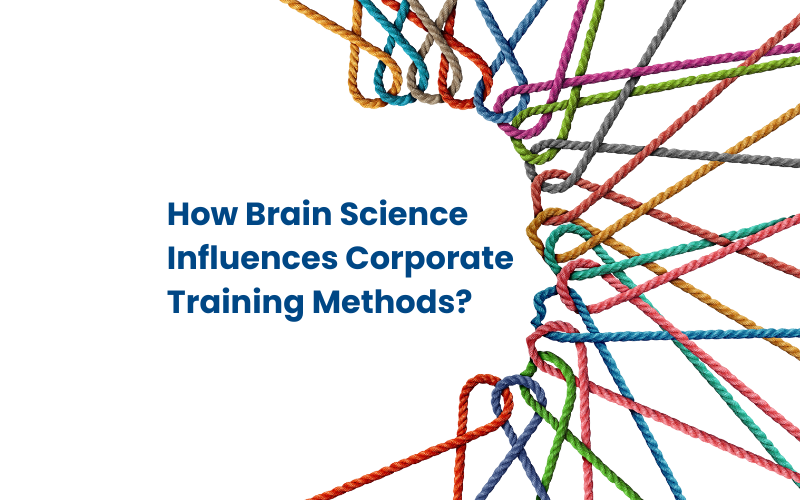Imagine you’re sitting in a corporate training session, struggling to keep your eyes open as slide after slide of dense text drones on. Now, picture a different scene: you’re engaged in a training module that adapts to your learning pace, uses interactive scenarios that light up your brain’s reward centres, and actually helps you retain information long after the session is over. This isn’t just a fantasy. It’s the promise of applying neuroscience to corporate training.
The Basics of Neuroscience in Learning
Understanding Brain Plasticity
Neuroplasticity, or brain plasticity, is the foundation of learning and memory. It refers to the brain’s ability to reorganise itself by forming new neural connections throughout life. This adaptability ensures that learning can occur at any age, influenced by experiences, environment, and behaviour.
Dr. Sarah Johnson, a neuroscientist specialising in learning and memory, explains, “Neuroplasticity is what allows us to learn new languages, solve complex problems, and acquire new skills. It’s the physical manifestation of learning in the brain.”
The Role of Emotions in Learning
Emotions play a crucial role in learning, significantly influencing attention, memory retention, and decision-making. The limbic system, which includes the amygdala and hippocampus, is central to emotional processing and memory formation. Positive emotional experiences can enhance learning by increasing engagement and motivation, while negative emotions can hinder the learning process.
According to a study published in the “Journal of Neuroscience,” emotionally charged material is more likely to be remembered than neutral material. This underscores the importance of creating positive, engaging learning environments that stimulate emotional and cognitive engagement.
The Importance of Sleep in Learning
Sleep is another critical factor in the learning process, allowing the brain to consolidate memories and process information. During sleep, particularly during the rapid eye movement (REM) phase, the brain sorts and stores the day’s learning experiences, integrating new knowledge with existing memories.
Research by Dr. Matthew Walker, author of “Why We Sleep,” highlights how sleep deprivation can significantly impair the brain’s ability to learn and form new memories. This finding has profound implications for designing training schedules and understanding individual learning capacities.
The Impact of Stress on Learning
While stress is a natural response to challenging situations, chronic stress can impair brain function, particularly in areas critical for learning and memory. The prefrontal cortex, responsible for higher-order cognitive functions such as planning, decision-making, and impulse control, is especially vulnerable to the effects of prolonged stress.
Studies have shown that stress can disrupt neuroplasticity and impair memory formation. Recognizing the impact of stress on learning, educators and trainers are increasingly incorporating stress management techniques into their programs, such as mindfulness meditation and physical exercise, to enhance learning outcomes.
Applying Neuroscience to Enhance Learning
Understanding these basic principles of neuroscience provides valuable insights into optimising learning strategies. For instance, incorporating spaced repetition, leveraging the emotional impact of content, ensuring adequate sleep, and managing stress can all contribute to more effective learning experiences.
Educational and training programs are beginning to apply these insights, designing curriculums that align with how the brain naturally learns and processes information. By acknowledging the role of neuroplasticity, emotions, sleep, and stress in learning, educators and trainers can create more engaging, effective, and personalised learning experiences.
The Connection Between Neuroscience and Corporate Training
Leveraging Brain Science for Effective Learning
Personalisation of Learning: Understanding that each brain is unique has led to the development of personalised training programs. Neuroscience reveals differences in how individuals process information, suggesting that personalised learning paths can significantly enhance engagement and effectiveness. Adaptive learning technologies, which use algorithms to adjust content based on an individual’s performance and learning pace, are a practical application of this insight. They ensure that employees are neither bored with content that’s too easy nor overwhelmed by content that’s too difficult.
Emotion and Learning: Neuroscience has highlighted the pivotal role of emotions in learning. Positive emotional states are linked to better memory retention and higher engagement levels. Corporate training programs are increasingly incorporating storytelling, gamified elements, and relatable scenarios that evoke positive emotions, making learning more memorable and engaging.
Microlearning: The brain’s attention span is limited, with studies suggesting a focus on intense concentration for about 20 minutes at a time. Microlearning—short, focused learning units that cover a single topic or concept—caters to this aspect of brain function. By breaking down complex information into digestible pieces, microlearning facilitates better attention management, encourages repeated engagement, and supports the brain’s capacity for memory consolidation.
Spaced Repetition and Retention: Neuroscience shows that spaced repetition, the practice of reviewing material over increasing intervals, significantly enhances long-term memory retention. Corporate training programs are integrating spaced repetition into their learning platforms, using reminders and follow-up quizzes to reinforce key concepts over time.
Integrating Neuroscience Principles into Corporate Training
To effectively integrate neuroscience principles into corporate training, organisations should:
- Embrace Technology: Utilise adaptive learning technologies to personalise learning experiences.
- Incorporate Emotion: Design content that connects with learners emotionally through storytelling or real-life scenarios.
- Focus on Microlearning: Break down complex information into short, manageable segments that cater to the brain’s attention span.
- Apply Spaced Repetition: Use spaced repetition techniques to enhance memory retention and facilitate long-term learning.
- Manage Cognitive Load: Ensure training materials are designed to avoid overwhelming the brain, using multimedia principles effectively to balance cognitive load.
Case Studies: Neuroscience in Action
One notable example is TechForward Inc., which redesigned its training program based on neuroscientific principles. They introduced gamified elements that leveraged the brain’s reward system, personalised learning paths to cater to individual learning styles, and incorporated frequent testing to enhance memory consolidation. The result? A 40% increase in learning retention and a 25% improvement in employee performance metrics.
Trends and Innovations
Immersive Learning Technologies
Virtual Reality (VR) and Augmented Reality (AR): Immersive technologies such as VR and AR are revolutionising corporate training by creating realistic, engaging environments for learners to practise skills and apply knowledge in safe, controlled settings. VR simulations are particularly effective for technical training, soft skills development, and empathy training, allowing employees to experience scenarios from multiple perspectives. These technologies capitalise on the brain’s learning mechanisms by providing experiential learning, which is known to enhance retention and transfer of skills to real-world situations.
Adaptive Learning Platforms
Personalised Learning Experiences: Adaptive learning technologies use AI and machine learning algorithms to analyse a learner’s interactions and performance, adjusting the content in real-time to meet their learning needs. This approach mirrors the brain’s learning process, offering personalised paths that improve engagement and efficacy. By catering to individual strengths, weaknesses, and learning speeds, adaptive platforms ensure that all learners achieve mastery at their own pace, making learning more efficient and effective.
Gamification and Engagement
Leveraging the Brain’s Reward System: Gamification incorporates game design elements in non-game contexts, such as points, badges, and leaderboards, to enhance motivation and engagement in learning. This trend taps into the brain’s reward system, stimulating dopamine release which enhances memory formation and motivational drives. Well-designed gamified training programs can significantly increase engagement and motivation, leading to higher completion rates and better learning outcomes.
Neurofeedback and Real-time Analytics
Optimising Learning Through Feedback: Neurofeedback systems use brainwave monitoring technology to provide real-time feedback on learners’ cognitive states, helping them develop greater awareness and control over their focus and attention. Combined with analytics, trainers can adjust training strategies to optimise learning efficiency and effectiveness. This trend underscores the importance of feedback in the learning process, as immediate insights can help adjust efforts for better outcomes.
Social Learning and Collaboration
Enhancing Learning Through Social Interaction: Neuroscience research highlights the importance of social interaction in learning, as it can enhance cognitive processing and memory retention. Corporate training programs are increasingly incorporating collaborative tools and platforms that encourage social learning, such as group challenges, peer feedback, and community forums. These tools not only leverage the social aspects of learning but also facilitate knowledge sharing and reinforcement within the organisation.
Continuous Learning and Microcredentials
Fostering a Culture of Lifelong Learning: With the rapid pace of change in most industries, continuous learning has become a necessity. Organisations are supporting lifelong learning through microcredentials and digital badges that recognise and certify the acquisition of new skills and knowledge. This approach not only motivates employees by providing tangible evidence of their achievements but also supports the organisation’s adaptability and competitiveness.
Challenges and Considerations
Despite the promise of neuroscience in corporate training, it’s not without its challenges. Ethical considerations around neuroenhancements and privacy concerns about brain data are sparking debate among scholars and practitioners alike.
Professor Alex Rivera, an ethicist, cautions, “As we venture into this new frontier, it’s crucial to balance the benefits of neuroscientific applications with respect for individual privacy and autonomy.”
What’s Next?
The intersection of neuroscience and corporate training opens up exciting possibilities for the future of learning in the workplace. By understanding and leveraging the way our brains work, we can create training programs that not only engage and entertain but also deeply embed knowledge and skills in employees’ minds.
As we look ahead, the potential for neuroscience to revolutionise corporate training is immense. It invites us to reimagine learning not as a chore but as a dynamic, interactive journey that resonates with the very wiring of our brains.
MDA Training stands at the forefront of this transformative journey, leveraging the latest neuroscience research to craft bespoke training solutions that meet the unique needs of your organisation. Our programs are designed to engage your employees fully, enhancing learning retention and applying these insights to achieve tangible business outcomes.
Don’t let your training programs lag behind in leveraging these groundbreaking insights. Get in touch with MDA Trainers today to discover how we can help you transform your corporate training initiatives and unlock the full potential of your employees.










